
Inside DM Engage, recommendations for books cover a wide range of subjects.
If you use the #DMReadingList hashtag you’ll see loads of them. But it’s copywriting books that tend to be the most discussed. Because how you tell your story, connect with your audience, and get them to convert comes down to how you systematically assemble language.
Below are some of the most beloved books about copywriting, according to actual members of the DM Engage Facebook community.
Storynomics by Robert Mckee and Thomas Gerace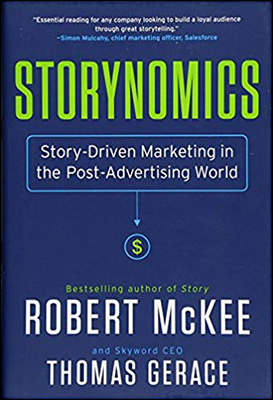
Rich Cook—Owner and Founder of Tales of Murder Press, LLC | Engage Member Since October 2014
McKee is a master Hollywood script doctor and story fixer. He applies his decades of storytelling study and teaching to business story. But more than just applying “story” to ads, McKee demonstrates how to go beyond traditional and interruption marketing/advertising to connect with your audience through story.
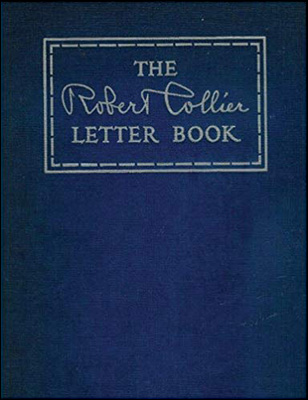 The Robert Collier Letter Book by Robert Collier
The Robert Collier Letter Book by Robert Collier
Jim Hart—Partner at Client Rush Marketing | Engage Member Since December 2017
This book presents an explanation of the classic outline for any ad or sales letter. It is probably most known for the idea of “entering the conversation already taking place in your prospects mind.” But it also furthers the concept of selling the transformation instead of the product. It is loaded with actual sales letters that brought in millions of dollars.
It is not so much a book to be read as it is to study the examples. Everything I write follows his outline.
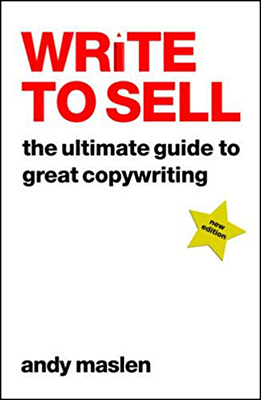 Write to Sell by Andy Maslen
Write to Sell by Andy Maslen
Simon Currigan—Joint Founder at Beacon School Support Ltd. | Engage Member Since August 2018
This is a short, practical book that doesn’t waste time on theory—it just tells you exactly what to do to write great copy. Andy explains how to keep your prospect’s eyes locked onto your copy by speaking to them at an emotional level (comparing their needs to the 7 deadly sins). He also reinforces the importance of using concrete, tangible language so your copy sounds credible, and looks at different ways of framing your offer (leading the prospects toward their desire or away from their fears).
This book really helped whip my copy into shape. I use these techniques all the time—and now my copy is shorter and sharper. The proof can be seen in better email click-through rates and my Facebook ad relevancy scores (consistently 9s or 10s).
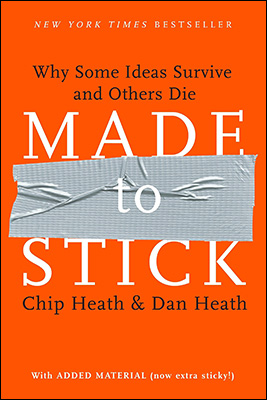 Made to Stick by Chip and Dan Heath
Made to Stick by Chip and Dan Heath
Hunter Willis—President of Webstore Solutions, LLC | Engage Member Since November 2016
This is by far (far, far, far) my favorite business book; it’s one I’ve read a dozen times and given away 50+ copies to friends and clients. In it, the authors give a framework on how to communicate good ideas in a way that makes them memorable. In order to have SUCCESs in making your ideas “stick” with others, you need to present them in some combination of the following principles:
S = Simple
U = Unexpected
C = Concrete
C = Credible
E = Emotional
S = Stories
s = This one is just an “s”
Each chapter is full of examples of where the principle was used by other businesses in an effective manner, so you walk away thinking, “This makes sense and I can take action on it immediately.” I’ve used these techniques to drastically improve my close ratio, generate money for clients, and in parts of my everyday life. I can’t recommend it enough.
My earliest use of these principles was when I worked as a financial advisor for a company that managed retirement plans for non-profits. We spoke to some employees who had been homeless just a year or 2 prior and had jobs that didn’t pay very well, so income was tight and every dollar counted. Before reading this book, I’d do a review and ask, “Would you be interested in increasing your contribution by 1%?” Only 1 out of 20 would say “yes.” But when I made it more “concrete” and said, “Would you like to increase your contributions by 1%? It works out to about $10 per paycheck,” 1 out of 5 would say “yes.” 1% was meaningless to them—they needed that percentage. But $10 meant something and they knew they could invest that extra $10 and not miss it.
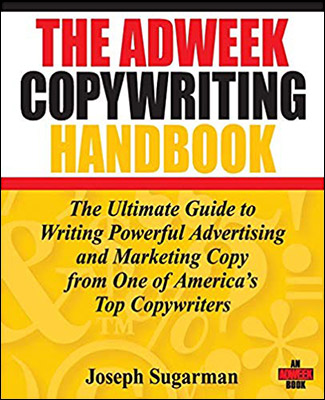 The Adweek Copywriting Handbook by Joseph Sugarman
The Adweek Copywriting Handbook by Joseph Sugarman
Craig Andrews—Principal Ally at allies4me Marketing | Engage Member Since September 2017
There were lots of things I learned from this book, like lead with a 3–5 word opening sentence. Finish your paragraphs with complete sentences, but incomplete thoughts to keep the reader engaged. Sow seeds of curiosity to hook the reader into your story. Joe breaks down the elements of an ad according to their purpose in simple terms that anyone can apply.
I’ve implemented many things from it in my own business. The concept of ending paragraphs with complete sentences with incomplete thoughts has been powerful. Now I can write 1500 words of copy that keeps readers hooked—even if they’re reading on their mobile phone.
(NOTE: Need a helping hand with your digital marketing efforts? Or maybe you just want proven, actionable marketing tools, tactics, and templates to implement in your business? Check out the latest deal from DigitalMarketer, and you will be on your way to helping your business grow.)
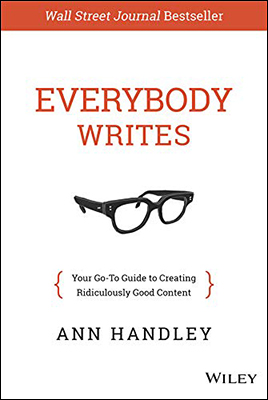 Everybody Writes by Ann Handley
Everybody Writes by Ann Handley
Alexandra Martel—Professional Copywriter at Les Mots pour Vendre | Engage Member Since January 2018
To me, this book is the Bible of copywriting. I love its premise, because it’s a simple, but powerful, truth: everybody writes. (And anyone can write well.)
There are several things from this book that I have used. The best thing about Ann Handley’s book is that it’s easy to skim through. You don’t have to read everything. You can cherry-pick the guidance you need, and then skip the rest. My favorite chapters every marketer should read are 2, 3, 9, 10 and 36.
Sell with a Story by Paul Smith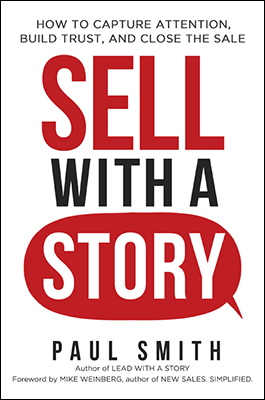
Kyle Porter—Marketing Coach | Engage Member Since September 2017
Sell with a Story gave me a clear framework to develop an elevator pitch for my business, bring customers into the adventure that’s waiting for them (that I can help them navigate) and really cast a vision for what their life will look like on the other side of the obstacles they face in starting or growing their business. The book doesn’t waste any space with fluff—example after example that fill pages but don’t add any value. Smith makes his point clear, gives actionable insight into how it can be applied, shows you how it’s been done, and then moves on. I treat it more like a reference book than anything else because it gives me the tools not only to explain my own experiences with compelling stories, but to craft stories that create connection with my customers and clients.
I used Sell with a Story to get really clear on exactly what I offer, beyond lists of features and benefits. When I started thinking about my customer experience from the framework of a story—a character with a mission who encounters conflict and has to overcome it—I had a really easy fill-in-the-blank template that’s allowed me to craft compelling sales copy and land clients.
Writing Without Bullshit by Josh Bernoff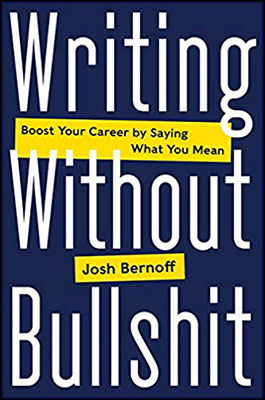
Rod Solar—Director of Practice Development Consulting at LiveseySolar | Engage Member Since March 2018
Focusing on treating the reader’s time as more valuable than your own, Bernoff’s indispensable guide helps you cut through the noise in emails, reports, and web copy so you can stand out.
Since reading, I’ve sharpened my headlines, tightened my subject lines, and strengthened my opening statements. I’ve banished jargon, wimpy passive voice, and tentative weasel words. Now, my voice is active and bold; I write directly to the reader and get straight to the point without wasting a word.
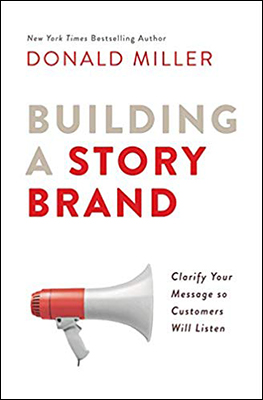 Building a StoryBrand by Donald Miller
Building a StoryBrand by Donald Miller
Sam Gale—Founder and Chief Content Strategist at Regale Media | Engage Member Since May 2018
It’s not a copywriting book, but it’s absolutely transformative regarding the way we talk to our audience and talk about our brands. The power of narrative is absolutely essential in marketing, and as an award-winning memoirist-turned-brand expert, Miller is especially able to address the why and how of good brand storytelling. The advice is both theoretical and practical, allowing for a full shift in approach. My writing has been far more compelling and easier to write since I read this book.
The hero/guide dynamic is one of the first things I discuss with each new client, and Miller’s principles for simplification are truly mind blowing and game changing.
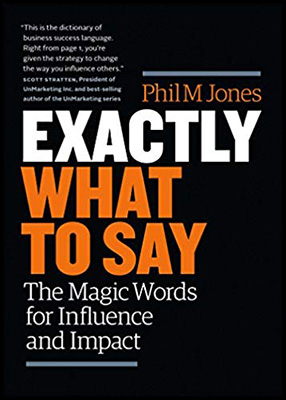 Exactly What to Say: The Magic Words for Influence and Impact by Phil M. Jones
Exactly What to Say: The Magic Words for Influence and Impact by Phil M. Jones
Sarah Arrow—Creative Director at Online Visibility Academy | Engage Member Since December 2014
Exactly What to Say: The Magic Words for Influence and Impact shows you how to have a persuasive conversation, what words matter and why they matter, and that fits perfectly into your structure as suggested by Ray Edwards. I’m lost without this book.
I use these ideas everywhere. They’ve increased my email click throughs, my sales and my upsells. The biggest area of impact has been using the suggested language in webinar sign ups. One webinar went from 3 sign-ups a week (organic traffic) to 60. I also shot to the top of a leaderboard in an affiliate contest (for the first time ever) using some of the I&I words in email broadcasts.
On the Art of Writing Copy by Herschell Gordon Lewis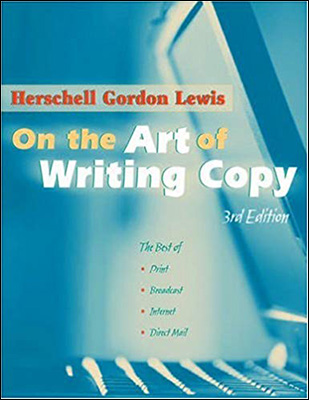
Kathleen Hanover—marketing copywriter, copywriting trainer, and speaker | Engage Member Since June 2017
Although it was published over 30 years ago, this epic coffee-table-sized book contains innumerable nuggets of scientifically-based copywriting wisdom, illustrated with numerous reprints of classic ad campaigns and copywriting samples. You’ll learn very specific, proven techniques for various projects like direct mail, radio ads, press releases, fundraisers, and catalog copy (the book is pre-Internet), many of which are published with before-and-after copy samples so you can see what a difference technical mastery makes in your copy.
My work has benefitted immensely from Herschell’s innumerable laws for copywriting that range from the philosophic (“Don’t let any piece of copy off your desk until you can say without crossed fingers, ‘My mother would understand it'”) to the granularly specific (“When a sentence has too many commas, consider using parentheses instead of one pair of commas. You can speed up both reading and comprehension.”) His advice makes my copy more effective, period.
(NOTE: Need a helping hand with your digital marketing efforts? Or maybe you just want proven, actionable marketing tools, tactics, and templates to implement in your business? Check out the latest deal from DigitalMarketer, and you will be on your way to helping your business grow.)
https://www.digitalmarketer.com/blog/copywriting-books/?utm_source=house-list&utm_medium=email&utm_campaign=dmblog-04-17-2020&tclid=dnrwcvk1-ttdd-clbl-nwgw-enhjq2fxdz09




Комментариев нет:
Отправить комментарий